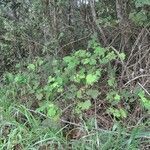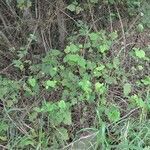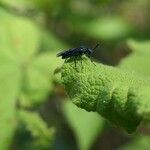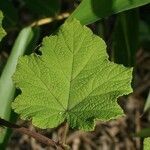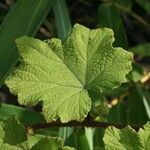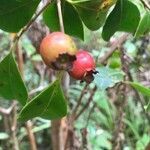Shrubs with arching or climbing branches up to 5 m long. Stems rather densely covered with patent and straight hairs, mixed with shorter and thinner hairs and with stalked glands, prickles usually rather many, stout. Leaves orbicular to broadly ovate in outline, (10-)12-26 by (9-)12-26 cm, 5-7-lobed with up to 4 cm deep incisions, lobes rounded and shallowly lobed, base deeply cordate, margins grossly and evenly serrate, apex obtuse to acute, herbaceous to slighdy coriaceous, nervation pedate with 5-7 pairs of nerves, venation reticulate, sometimes the upper surface distinctly bullate between the veins, upper surface hairy, lower surface with a usually closed felt of short, curly hairs and with many long, patent hairs on the nerves. Petiole 3-11 cm long. Stipules often rather persistent, orbicular in outline, up to c. 2 cm, deeply digitately divided with the lobes pinnate, lobes thread-like, at most 0.3 mm wide, hairy outside and on margins. Inflorescence a terminal compound raceme with 12 or more laterals, the lower of them in the axils of leaves, up to 50 cm long, the lateral racemes up to 12 cm long, all axes terminating in a flower. Bracts rather persistent, pin-natifid to-partite, with thin lobes. Pedicels 1-1.5 cm long, densely hairy as are all axes in the inflorescence. Flowers bisexual, flower buds ± globular. Hypanthium cup-shaped, 6-9 mm across, densely woolly and with long patent hairs outside. Sepals ovate, 6-10 by 4-7 mm, acute to acuminate, not-covered margins with 2-5 teeth up to 2(-4) mm long, indumentum outside as hypanthium. Petals early falling, orbicular, 5.5-9.5 by 4.5-9 mm, distinctly clawed, rounded or notched at apex, white. Stamens 160-230, filaments up to 5 mm, anthers 0.5-0.8 mm long, with long hairs. Pistils up to 150, ovaries glabrous, on elevated, glabrous torus, style up to 10 mm long. Collective fruits globular, c. 1 cm, sepals under ripe fruits spreading. Fruits 2-4 by 2-3 mm when dry, red, mesocarp juicy, a thin layer when dry.
More
A climbing shrub. It can be 6 m tall. The thorns on the stems are 4 mm long. The leaves have 5-7 lobes. The leaves are 5-20 cm long and wide. There on hairs on the top side and very hairy underneath. There are thorns along the midrib. The leaf stalks are 2-5 cm long and have thorns along the underside. The stipules are divided and spread out. The flowers can be single or in clusters in the axils of leaves or at the ends of branches. The flowers are white and 7-10 mm long. They have 5 petals. The fruit is an aggregate berry. It is orange or red and 2-3 cm long. There are many seeds.
In light places like forest edges, roadsides, secondary forest, thickets, and riverbanks, sometimes descending to sea level, but more commonly found at elevations from 500-1,400 metres.
More
In light places like forest edges, roadsides, secondary forest, thickets, and riverbanks, sometimes descending to sea level, but more commonly found at elevations from 500-1,400 metres.
A tropical plant. It grows in warm regions. It grows in secondary undergrowth between 500 and 1800 m altitude.
Can be grown by cuttings or seedlings. Seeds needs stratification.
